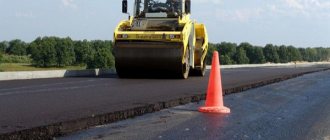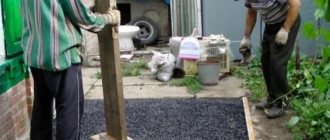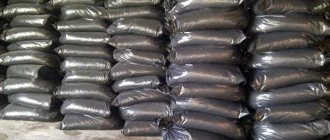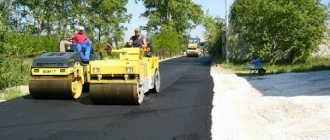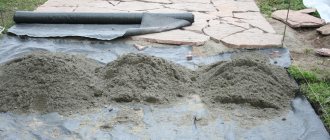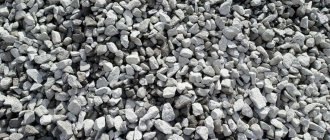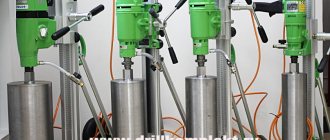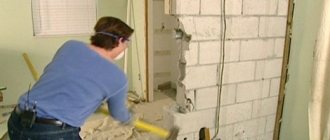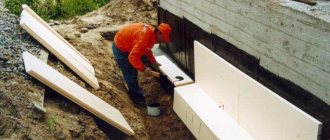Home › Articles › Paving slabs › Which is better: paving slabs or asphalt
The final stage of construction of a private house is the improvement of the surrounding area. Every owner thinks about the question of how to pave the paths and areas on his site. There are several options for solving this problem, the most common of which are paving with asphalt or paving slabs.
Methods of laying asphalt
In cold asphalting, the mixture is based on liquid petroleum road bitumen.
The peculiarity of the work is that installation is possible only in the warm season. This is because the water drying step is not used. This paving method is well suited for pothole repair. During hot asphalt paving, the main components of the mixture are liquid and viscous petroleum bitumen. The peculiarity of installation is that work can be carried out in winter, when it is cold outside. In order for the asphalt coating to be durable, the temperature of the asphalt during laying according to GOST must be at least 120 degrees. The area where asphalt is planned to be laid is pre-dried using special equipment.
Asphalt: types and classification
Asphalt is a finished road surface made from asphalt or asphalt concrete mixture. Asphalt or asphalt concrete mixture is a ready-made mixture of bitumen with mineral materials: crushed stone or gravel, sand (possibly with the addition of mineral powder). Asphalt is used for making road surfaces, for waterproofing, as a roofing material, and for making putties, adhesives, and varnishes.
The highest quality asphalt is used in painting and in the creation of lithographs.
Asphalt can be of natural and artificial origin: in natural mountain asphalt there is 60-75% bitumen, in artificial - 13-60%. Asphalt is often called asphalt concrete - an artificial stone material that is obtained by compacting asphalt concrete mixtures.
Classic asphalt concrete consists of crushed stone, sand, mineral powder (filler) and bitumen binder (bitumen, polymer-bitumen binder; tar was previously used, which is not currently used). COARSE-GRAINED – for the lower layers of two-layer asphalt concrete pavements. FINE-GRAIN – for the construction of main federal roads and streets with high traffic intensity.
SAND – for pedestrian paths and sidewalks, car parking areas, retail areas. MIXTURES WITH POLYMER-BITUMEN BINDING - to increase the durability of coatings. MIXTURES WITH RUBBER-BITUMEN BINDING (BITREK).
MIXTURES WITH UNIREM MODIFIER. RUBBER-ASPHALT CONCRETE MIXTURES – coatings of reduced rigidity, for example, for covering stadiums and running tracks.
Criteria for evaluating the material you are going to use
All the equipment presented above is used when paving roads. To properly lay asphalt and give it strength and durability, you need to carefully follow all the stages of laying the pavement and use specialized equipment. Only a heavy machine is capable of compacting layers of asphalt concrete pavement well in order to minimize voids and provide the road surface with high density.
High-quality step-by-step execution of all work guarantees the coating high performance properties and a long service life.
Our company Vector LLC offers you rental services for a soil vibratory roller and other special equipment needed at different stages of work on laying a new roadway at low prices. We also offer supplies of inert materials to construction sites.
You don't need a lot of materials to repair potholes in your yard or on your driveway. So, if the depth of the hole is up to 20 cm, you will not need anything other than cold asphalt.
Next we will briefly explain what these materials are and why they are needed.
Crushed stone
It is needed to fill the bottom of the hole and save money on rather expensive cold asphalt. In addition, crushed stone provides better adhesion between the asphalt and the base and gives strength to the repaired surface. Thanks to the crushed stone cushion, the asphalt will not sag under pressure.
Please note that crushed stone can consist of grains of different sizes. Some large rocks may even exceed the size of your hole. Therefore, be sure to pay special attention to the fraction of the material.
The best option for filling the hole would be crushed stone with a grain size of up to 40 mm.
In this case, you can combine different fractions, filling the voids between large stones with smaller ones (that is, doing clinching).
As for the rock, we advise you to opt for inexpensive materials: granite or crushed limestone. After all, it makes no sense to buy expensive types for pothole repair. But, of course, you can take other types of crushed stone (diorite, serpentinite, amphibolite and others). The only thing is to take into account the strength of the material (it is designated by the letter “M”). Ideally, it should be from M600 (medium strength) and higher. Then the material will be able to withstand sufficient loads.
The binder component is usually used in the repair of federal highways and highways with high traffic. It is needed for better adhesion of asphalt to the lower layers of the coating, the bottom and edges of the pit.
It is better to choose slow-thickening (MG), partially oxidized (MGO) or medium-thickening (SG) brands:
- MGO 70/130
- SG 40/70
- MGO 130/200
The numbers indicate possible viscosity ranges. They are determined in laboratory conditions by the degree of penetration of a thin needle into the mass of material. In southern latitudes it is better to use materials with a small viscosity range (for example, 40/70); for northern latitudes, MGO 130/20 grades are more suitable, and in temperate latitudes - 70/130.
Bitumen can be replaced with an emulsion. Water is added to it with emulsifiers, which slow down the separation of bitumen and H2O molecules. Bitumen emulsion is convenient to spray and apply to the surface, it is non-flammable, can be used at low temperatures, and has better adhesive properties. Impregnation can also be done with tar (an oil refining product). It is recommended to use it to save money when processing the walls of small pits.
Cold asphalt
This is the most important material, which, by and large, can be used independently, without improvised means. Unlike hot asphalt concrete, cold asphalt contains less bitumen (4-6%). Its viscosity is low or medium. The material hardens due to the evaporation of carbohydrate compounds from its surface.
Cold asphalt can be fine-grained (mineral particles up to 20 mm) and sandy (up to 5 mm). The first option is more durable and suitable for patching roads, parking lots, and sidewalks. The second can even be used to level the surface and backfill small areas.
In the next part we will tell you under what conditions it is allowed to lay the material.
The main criteria for assessing the choice of coating material are the following:
- the ability to quickly deliver materials to their destination;
- their cost (including delivery, unloading, installation of the coating and its ongoing repair);
- service life;
- labor costs to maintain the coating in good condition.
What should be the thickness of asphalt in the yard?
// If we talk about roads on which cars drive, including multi-ton trucks, and not about pedestrian paths, then the preparation technology before laying asphalt is much more complicated.
If the fertile layer of soil has already been removed and the sand cushion has already been compacted, then the next stage will be crushed stone flooring.
Crushed stone will be required in different fractions. The total layer should be 25-35 cm.
The first layer of crushed stone should be from a fraction of 40-70 mm. It will also serve as drainage from groundwater. It will be about 20 cm.
The next layer is made from a fraction of 20-40 mm, 5-10 cm thick. This smaller crushed stone will ensure uniform distribution of the load when rolling the road.
Many builders also lay down a third layer from a fraction of 5-20 mm up to 5 cm thick. Now you can lay asphalt. The thickness of the cushion of crushed stone and the asphalt layer depends on the expected load on the road surface.
If the asphalt path is for pedestrians and cyclists, then a thickness of a layer of crushed stone (middle fraction) of 15 centimeters is sufficient, on which only one layer of asphalt is laid. The proportions and production standards are regulated by GOST, but many manufacturers ignore this rule and use cheap substitutes. This is not reflected in the best way on the quality of the asphalt mixture, so it is preferable to order this product from truly trusted companies, for example, representative offices. According to GOST requirements, asphalting roads and sidewalks must be carried out under suitable weather conditions.
Stages of paving a summer cottage
Before laying asphalt pavement at a reasonable price, our company will carry out a number of measures that will ensure the quality of the pavement and its long service life.
- When paving a summer cottage, work begins with preparing a plan and marking the territory.
- At the site of future asphalt platforms and paths, the top layer of soil is removed. As a result, the asphalt surface will be equal in height to the level of the earthen cover. The soft soil at the dacha is permeated with a large amount of green mass and roots. Over time, organic inclusions will decrease in size as they rot, and the soil will become mobile, destroying the coating.
- Large tree roots extending into the asphalt area must be removed without fail. The roots have great destructive power; they are capable of breaking even a very thick layer of asphalt concrete pavement, so care should be taken to neutralize them in advance.
- In the bed resulting from removing the top layer of soil, a sand-crushed stone cushion is laid, carefully compacting the base. At the same time, side stones are installed. Curbs prevent the edges of the asphalt from collapsing prematurely and give the entire structure a complete, finished look.
- The final stage is the direct laying of asphalt concrete. When paving a summer cottage, we will lay the surface using hand tools or compact special equipment. The thickness of the final coating is 4-5 cm. This layer of asphalt in the yard is enough to withstand light loads and withstand the effects of adverse weather conditions without damage in the form of cracks and chips.
We suggest you familiarize yourself with What kind of water to pour into a clothes steamer
The project should be developed taking into account the characteristics of the site, which has its own individual characteristics (type of relief, parameters, soil structure). After the specialist’s calculations, an estimate is drawn up, which takes into account:
- plot size,
- volume of work,
- preliminary cost.
The location of underground communications is also included in the calculation. This is necessary for the correct calculation of the drainage system, which will help avoid problems with wastewater disposal in the future.
Due attention should be paid to the root system of large trees, as over time the roots can grow and seriously damage the road surface.
Excavation
Preparatory work begins. First of all, the top layer of soil is removed. If the task is to remove a large layer, the use of specialized equipment - bulldozers and loaders - is required. The territory is leveled using graders. Subsequently, a road “trough” is formed, which will undergo further compaction.
How deep to dig? First of all, the indicator depends on the purpose of the roadway. To lay paths, it is enough to remove 15-25 cm of soil. The rule applies here: the greater the planned load on the canvas, the deeper the pit is dug.
Important! The project should be designed so that rainwater flows into the drainage system and does not accumulate on or under the asphalt surface.
If the work is not done from scratch, the existing coating is destroyed using a road router. Obsolete coating can be reused if recycled correctly.
Do you want to buy sand or crushed stone with delivery?
Call now and get a discount 7 (988) 318-84-49
At this stage, a “road cushion” is formed. The task is to pour two layers of the road “pie”:
- Sand or gravel-sand mixture is laid.
- To give strength, the top of the coating is sprinkled with coarse crushed stone.
- To minimize voids, the cake is additionally covered with crushed stone with a fine fraction.
To ensure that the coating does not lose its quality characteristics over time, each layer must be leveled using a grader and carefully compacted. Side stone is used to fence off an asphalted area.
Important! To give the coating maximum strength, the surface should be impregnated with bitumen before paving.
Rules for paving the local area
The asphalt laying technology assumes that the artificial layer must be at the same level as the natural soil on the site. So first:
- remove part of the land
- compact the bottom
- a layer of sand and crushed stone is poured with the obligatory compaction of each layer.
At the end, bitumen is poured. Now you can roll the asphalt.
The negative aspects of using such a coating are that it is not environmentally friendly (the release of benzene and substances containing it into the air) and instability to high temperatures. Drivers and pedestrians often watch asphalt melt under the hot summer sun.
Advantages and disadvantages of concrete coating
Asphalt (artificial or natural) contains bitumen (waste from the oil industry) in combination with gravel (or crushed stone) and sand (it is the filler). Moreover, in the first version the amount of bitumen is 13-60%, and in the second it is about 60-75%.
On a note! Mineral powder is added to artificial asphalt.
Concrete consists of cement, sand, crushed stone of large fractions (this is the filler), water and artificial components. Depending on the binders, additives and fillers, coatings with different characteristics are obtained.
The main advantages of concrete pavement:
- Concrete is easy to mix and reliable in use. The coating made of this material can withstand significant loads without deforming.
- The service life can vary from 50 to 100 years.
- You can lay concrete in small areas yourself, without the help of specialists.
On a note! When laying over large areas, it is better to use factory-mixed concrete: this will prevent cracking at the joints of the coating from different batches.
- Repair work can be carried out at any time of the year.
Important! If it is necessary to repair potholes, then the presence of special equipment is not at all necessary.
- When heated, the concrete coating does not emit harmful substances.
- There is a wide range of materials for arranging concrete pavement. Moreover, to please the consumer, manufacturers pack the mixture in bags weighing 25 and 30 kg.
But this coating also has a number of disadvantages that are worth mentioning:
- Relatively high cost of materials.
- Formation of a layer of dust on the surface of concrete.
- Waves may form on the coating due to significant loads.
- In the event of a sharp temperature change, cracking of concrete occurs. As a result, water gets into the cracks, which freezes in the event of frost, causing larger openings and shortening the service life of the coating.
Choosing a covering for the yard: which one is better?
Is your yard undergoing major renovations or are you just building? So you are undoubtedly concerned about the issue of coverage. What to choose, asphalt that has been proven over the years or the now fashionable paving slabs? Or maybe concrete? What is safer for our health? Which of these materials can you install yourself? What advantages do these three materials have, and do they have any disadvantages?
Let's answer these questions by examining each type of coverage separately.
Asphalt
The advantages of asphalt include:
1. Very durable material, well suited for parking a car, does not deform, does not sag under pressure.
2. Well-laid asphalt has no gaps or cracks where grass can grow or debris can become clogged.
3. The material itself is inexpensive compared to paving slabs.
The main disadvantages of asphalt pavement are:
1. Impossibility of self-installation in the yard.
2. Aesthetic side. Newly laid asphalt has a beautiful black color, but after several years of use the color turns gray and small cracks appear.
3. The cost of installation can be several times higher than the cost of the material itself, plus the hourly payment for the work of the asphalt roller.
4. When exposed to direct sunlight, it begins to release dangerous carcinogenic substances.
Paving slabs
Let's consider the advantages of paving slabs:
1. It can be easily installed by yourself.
2. It has many color options, for example, to match the cladding of the house itself or the fence.
3. Laying patterns is possible.
4. Environmentally friendly material, does not emit carcinogenic substances when heated.
5. Easily dismantled in case of redevelopment of the yard.
6. Paving slabs are more durable than asphalt.
The disadvantages of paving slabs include:
1. In winter, it requires special care, since even slight moisture on the surface makes it very slippery.
2. Snow must be removed before it is trampled; removing ice can seriously damage the surface.
Concrete
Concrete is simple and reliable. Here are its main advantages:
1. Suitable for installation near the garage, does not deform.
2. Small areas can be laid independently; for large areas, factory-produced concrete is better suited; this will help avoid cracking at the junctions of different batches.
3. The cheapest type of hard surface for the yard.
4. Environmentally friendly, when heated there is no evaporation of bitumen resins, like asphalt.
There are many more disadvantages to this type of coating:
1. Short service life, only 5-7 years.
2. Does not tolerate temperature changes well and cracks. Water gets into the cracks, which freezes at negative temperatures, expanding the holes, which leads to the edges beginning to crumble.
3. In addition, the concrete surface is dusty.
Work with old coatings
The undoubted advantages of arranging an asphalt surface include:
- The costs of purchasing all the necessary materials are relatively low (for example, compared to concrete and paving slabs).
- The lead time for asphalt laying work is not too long.
- Asphalt is durable (does not sag or deform), so it is perfect for arranging garden paths or car parking spaces.
- The coating material is practically not subject to corrosion.
- High-quality asphalt does not have any cracks or gaps: therefore, grass does not grow through it.
The disadvantages of asphalting (which are much greater than the advantages) include:
- It is unlikely that you can cope with laying asphalt pavement on your own. Most likely you will have to resort to the help of a special team of workers who have heavy equipment in their arsenal to carry out the work.
- Asphalt is practically not suitable for repair. That is, if potholes and cracks appear on its surface, it is unlikely that it will be possible to patch them so that it is unnoticeable and without compromising the quality of the entire coating. Most likely it will be necessary to tear it off from the entire area and lay new asphalt.
- From an aesthetic point of view, the newly laid coating has a deep black color, but over time it changes to gray, which is less aesthetically pleasing.
- The service life of asphalt is short - no more than 7-8 years. After this period, the coating begins to crack and loses all the advantages described above. By the way, asphalt is especially susceptible to cracking during the cold season.
We invite you to familiarize yourself with Eleutherococcus tincture: properties and contraindications, how to take, reviews
Important! The duration of operation largely depends on the correct mixing of asphalt components.
- The cost of installation sometimes exceeds the cost of the material used, its delivery and unloading. Also, do not forget about the hourly payment of the employee who compacts the surface with a roller. And this is also an expense, and a decent one at that.
- Asphalt contains a component called bitumen. Firstly, it has a very specific smell and can cause a lot of discomfort to sensitive people. Secondly, under the influence of high temperatures, bitumen softens significantly (which leads to surface deformation even with minor mechanical impact) and begins to release carcinogenic substances.
- The asphalt surface does not allow water to pass through, and after rain, puddles remain on it for a long time.
Cut asphalt is a fairly popular material.
It has several advantages:
- Simplicity and ease of installationCutting is an independent material that does not require crushed stone, sand and bitumen for installation. You also don't need special equipment or special skills.
- Long shelf life Fresh asphalt from the plant must be delivered to the site and laid as soon as possible. Otherwise, it will cool down and turn into a stone monolith. There will be no such problems with cutting. Moreover, it can be stored outdoors even in winter.
- Availability in all regions All regions of Russia have asphalt road surfaces. Sooner or later, it needs to be replaced. This is how asphalt cutting appears - during road repairs and removal of old pavement.
The material also has its drawbacks. We must also mention them.
So, the disadvantages of using asphalt cuttings:
- Weak strength Compared to hot asphalt, this material is less durable and practically does not form a continuous coating. This is due to the fact that cuttings are a secondary product.
- An unpleasant odor may appear when the material is heated in the sun.
- No certification The quality of cutting is not standardized in any way, so the properties of different batches differ greatly from each other.
- Unaesthetic appearanceIn appearance, asphalt crumbs do not at all resemble asphalt. It can be of different colors, from dark brown to light gray. This limits the scope of its application (for example, in landscaping, courtyard and garden design).
- Seasonality and inconsistent shipments We have already said that cutting asphalt is a material available in any region. However, it appears only in warm weather and, as a rule, sells out quickly. Therefore, you need to order asphalt cutting in advance - several days, or even weeks.
Despite all its disadvantages, asphalt cutting is still in demand among buyers. This is due to the fact that its advantages outweigh the disadvantages several times: low price and ease of installation make this material in demand in private construction. After all, it makes no sense to overpay for expensive hot asphalt when arranging, for example, an entrance to a site or a parking lot near a house. In addition, by choosing cut asphalt instead of other types of asphalt, you will significantly save on additional materials.
Next, we will talk about the technology for laying cut asphalt and some points that are worth paying attention to. But before that, we will briefly mention what weather is best for laying the material.
Traces of old coverings are often found in dachas near Moscow. Destroyed asphalt, tiles or concrete paths can be a good basis for laying new communication routes.
Order services at an inexpensive price that improve summer cottages and courtyards of houses in Moscow and the Moscow region. Individuals, large and medium-sized companies come to us with this problem, so we have accumulated enormous experience in performing such work. The company's specialists regularly take advanced training courses, know about all the innovative technologies in this area and know how to use them in their daily activities.
The process of laying new asphalt is not much different from starting from scratch. Instead of removing the top layer of turf, remove dirt and debris from the old base. Preparatory work will increase the adhesion of the base to the new coating layer, which will increase the service life of asphalt areas. If there are chips and cracks in the concrete base, they must be widened as much as possible so that as much fresh asphalt concrete mixture can get inside.
Paving slabs
There are 2 methods used for production:
- Vibrocasting.
- Vibration pressing.
Vibropressed tiles have more precise dimensions . This type of product is cheaper due to large-scale production - full automation allows for huge production volumes.
Vibropressed tiles are made in different colors and textures . The rough surface does not slip, and the grip on car wheels is good.
Vibropressed tiles
For vibration-cast models, certain plastic molds and a vibrating table . If you have the skills and knowledge, you can produce paving slabs yourself, but the quality will be low.
Vibrocast tiles
For installation, the base is compacted . In case of high humidity, drainage is done. If cars will drive around the area, it is necessary to lay the product in a double layer.
There are gaps between the plates, 2-10 mm . They are covered with sand. Gaps are necessary for water drainage.
What equipment is used when paving roads?!
Bulldozer
A bulldozer is a self-propelled road construction machine with cyclic action. Equipped with a knife working body. Main purpose: carrying out excavation and transport work.
Bulldozers are widely used and are intended for all stages of construction work:
- to prepare the soil base,
- to apply a sand and crushed stone layer,
- to prepare the road base for asphalting.
Bulldozers are either tracked or wheeled. Crawler bulldozers are designed for work in off-road and difficult terrain conditions and have great power and endurance.
Wheeled bulldozers have lower productivity, but are characterized by high maneuverability. Can work in small areas. They are used for constructing road bases, while tracked ones are better suited for earthmoving work.
Loader
The loader is a self-propelled or manual machine. The main purpose is to lift, transport and stack heavy loads.
Bucket loaders are also divided into tracked and wheeled. The former have greater power, productivity and endurance, the latter are intended for simple work in small areas.
Loaders are universal equipment because they can be equipped with a wide variety of attachments:
- bulldozer blades,
- ladle,
- scraper working bodies, etc.
We suggest you read How to make an outdoor oven with your own hands
This technique is used for laying asphalt concrete pavement and subsequent cleaning of the area from construction debris, and, if necessary, fallen leaves, snow, branches, etc.
Grader
The main purpose of the grader is planning and profiling the work area. This is a self-propelled or trailed machine that is used to level the soil and then move it. It is also used for cleaning areas from loose construction materials and snow.
An asphalt concrete paver is a type of construction equipment that can be tracked or wheeled. The asphalt concrete paver is designed for laying asphalt concrete mixtures. Depending on the type of work to be done (their volume and complexity), machines can be heavy or light. Large equipment is needed at large road construction sites, while light equipment is used for auxiliary work.
| pp | Free services | Unit change | price, rub. |
| 1. | Surveyor's visit to the site | —— | —— |
| 2. | Consultation | —— | —— |
| 3. | Budgeting | —— | —— |
| pp | Preparing the road base | Unit change | price, rub. |
| 1. | Soil sampling with loading, removal and disposal | m3 | 390 |
| 2. | Territory planning using a vibratory roller | m2 | 70 |
| 3. | The construction of the base is made of sand, thickness 30 cm. | m2 | 250 |
| 4, | Construction of a base made of cement-sand mixture 5 cm | m2 | 130 |
| 5. | Construction of a base made of crushed gravel 15 cm thick | m2 | 320 |
| 6. | Warping device made of crushed limestone 10 cm | m2 | 200 |
| 7. | Warping device made of recycled crushed stone 15 cm | m2 | 165 |
| 8. | Construction of a base made of asphalt chips 15 cm thick | m2 | 140 |
| 9. | Construction of the base made of reinforced concrete thickness. 15 cm. | m2 | 870 |
| 10. | Treatment of the base with bitumen emulsion. | m2 | 18 |
| pp | Asphalting | Unit change | price, rub. |
| 1. | Installation of coarse-grained asphalt covering 4-5 cm thick | m2 | 460 |
| 2. | Installation of fine-grained asphalt 4-5 cm thick | m2 | 420 |
| 3. | Installation of sand asphalt covering 4-5 cm thick | m2 | 400 |
| pp | Road surface repair | Unit change | price, rub. |
| 1. | Pothole repair of asphalt pavement | m2 | 620 |
| 2. | Cutting thick asphalt 5 cm diamond blade | m.p. | 90 |
| 3. | Repairing road cracks | m.pog | 280 |
| pp | Improvement | Unit change | price, rub. |
| 1. | Applying road markings 10 cm wide | m.p. | 55 |
| 2. | Installation of road side stones | m.p. | 750 |
| 3. | Installation of lawn edging stones | m.p. | 670 |
| 4. | Installation and extension of well necks. | PC. | from 2100 |
| 5. | Landscaping of the lawn: filling the fertile layer of soil thick. 15 cm, sowing seeds | m | 250 |
| pp | Dismantling | Unit change | price, rub. |
| 1. | Dismantling of asphalt concrete pavement thickness. 5 cm with removal | m2 | 125 |
| 2. | Milling of asphalt concrete pavement thickness. 5 cm | m2 | 55 |
| 3. | Dismantling of curb stones with removal | m.p. | 100 |
| 4. | Loading and removal of garbage | m3 | 400 |
Asphalting a summer cottage solves the problem of bad weather. A landscaped dacha area with pedestrian asphalt paths, parking and paved access roads is an easily achievable dream for plot owners in the Moscow region.
offers services for asphalt paving of territories in cottage villages, gardening partnerships and simply in the courtyards of private country houses at an inexpensive price. Paving the yard of a private house is a popular service. Asphalt covering of small areas of the territory is carried out in a short time, and lasts a long time without repair or restoration work.
What to choose
Determining absolutely clearly which coating is better is not so easy. Much depends on factors such as:
- The main filler in asphalt is sand, and in concrete it is crushed stone of large fractions. It follows from this that concrete pavement is durable, but inferior to asphalt in aesthetics.
- The turnaround time for the construction of about 300 m² of asphalt pavement is about 2 days, which can be completed by a team of 4 people; and for concrete: 3-4 days for pouring and 28 days until complete setting (you can do everything yourself).
- The asphalt is smoother.
- The period of maintenance-free operation of concrete is 10-12 years, and asphalt is only 5-7 years.
- Preference should be given to a concrete surface if the proposed work is planned in the cold season.
- From an economic point of view: initially, concrete pavement in monetary terms costs 70-80 percent more than asphalt pavement. It is a fact. But we should not forget that asphalt is short-lived and after a short period of time its constant repairs begin. Thus, after 7-8 years (if we compare two types of coverage), it turns out that the costs of purchasing and maintaining each of them (that is, everything in a complex) will practically be equal.
- People and passenger vehicles can move on asphalt; the concrete coating can withstand everything, including trucks and heavy machinery. Therefore, if minimal movement is expected (that is, an average load on the pavement), then there is no point in overpaying and laying concrete.
- Asphalt can be damaged even due to minor mechanical impact. But, repair work can only be carried out in warm (and not rainy) weather.
Which is better: concrete or asphalt?
When arranging the local area, every homeowner faces a problem: how to cover the entrance, parking space, approach to the house? Maybe traditionally pave it? Or fill it with concrete? Let's try to figure out what is better, more durable and cheaper to use in private households.
Paved area
Before laying asphalt, the base is carefully prepared. To do this, the area is cleared, about 15 cm of soil is removed, and crushed stone or a sand-gravel mixture is poured. The thickness of the base should be sufficient so that the main coating does not wash away from below. Typically 10–15 cm of substrate is required. After the preparatory work, asphalt is laid in a layer of at least 5 cm. It is better to purchase a fine-grained version; in a small area it looks much more aesthetically pleasing and has a smoother texture. Next, curbs and sewer manholes are installed if they are in the construction zone. For greater strength, it is possible to lay a second layer, but this is not necessary. All work is carried out within 2 days by a team of 5 people.
This coating will last about 10 years with proper care. Every 3 years the area must be compacted using special sealants. During the operation of an asphalt pavement, a small but rather unpleasant issue is revealed: in hot weather, petroleum products used in production evaporate from it. They also penetrate into the surrounding soil along with rainwater, polluting the garden plot and disrupting its environmental friendliness.
Concrete slab
The construction of a concrete platform requires no less labor-intensive preparation. The soil is selected and the sand and gravel base is filled with a layer of at least 15 cm. After this, the surface is reinforced with steel or fiberglass rods, formwork is installed and mortar is poured. To ensure high performance, a concrete slab 10 cm thick is required. Curbs are placed along the edges. The process takes 3 days and can be completed independently, without the involvement of workers or special equipment. The main inconvenience is that the concrete needs to dry for two days, and only then can it be walked on. Full strength gain occurs within 28 days; before that, the car will have to be parked in another place.
Concrete can last up to 20 years if installed correctly. In large areas, it is desirable to install expansion joints, for example, by means of wooden slats laid across the base. During the first 7–8 years, the surface requires virtually no maintenance. The big advantage of concrete is that it is not covered by waves and does not evaporate harmful substances. However, the resulting coating is quite dusty.
What is more profitable?
Initially the cost of 1 sq. m of asphalt is somewhat cheaper than the same area of a concrete slab. You can calculate this by finding out the cost of a machine of concrete and a similar volume of asphalt. However, due to the greater durability of concrete and its ease of maintenance, the total costs are compared after 5–7 years.
Which is better: concrete or asphalt?
